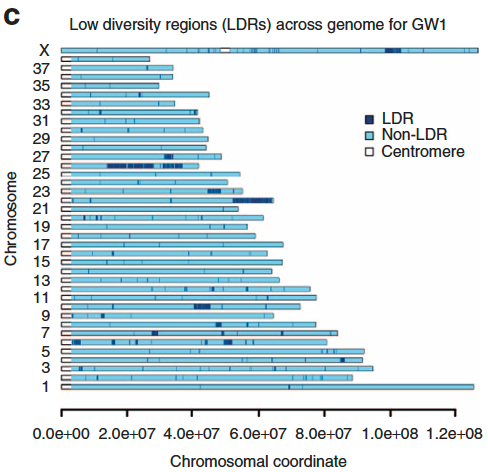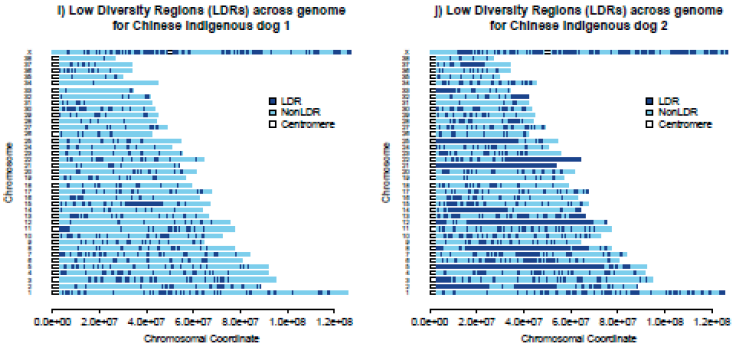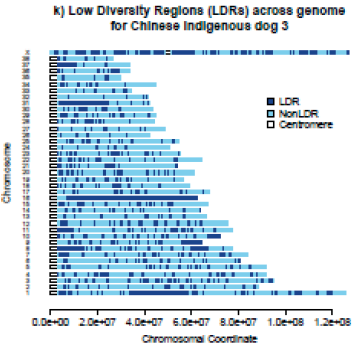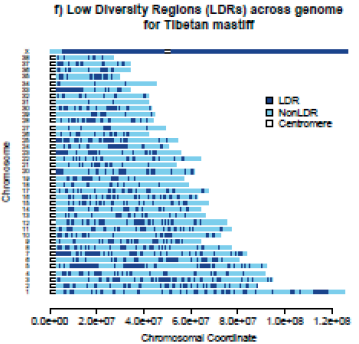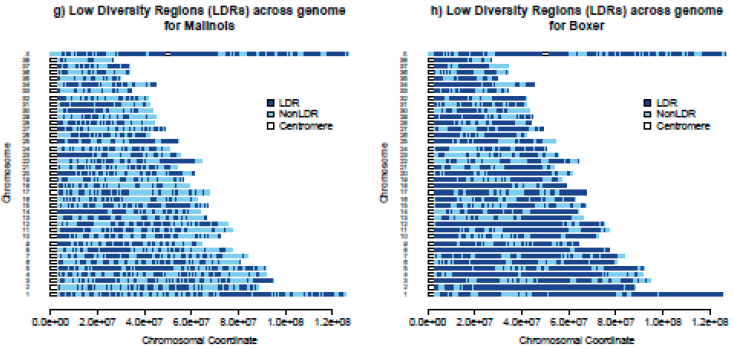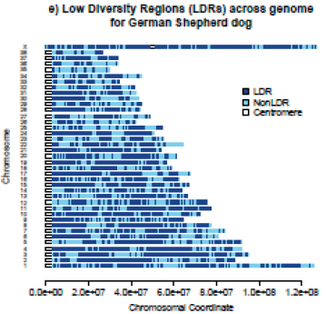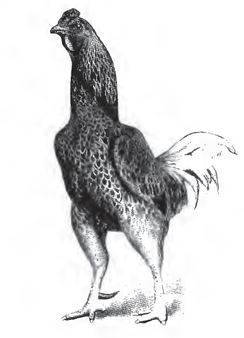From an historical perspective, dogs and humans grew up together. The dog was the first domesticated animal, and dogs have traveled the world with us in both space and time. Research is just starting to address the parallel genetic changes that occurred in humans and dogs in response to environmental challenges such as high altitude or changes in diet. These studies make for fascinating reading, and I was really excited to find a recent paper that presented data for Grey wolf, Chinese indigenous dogs, Tibetan mastiff, and various European breeds, with the intent of comparing the parallel genetic evolution of the dogs with humans (Wang et al 2013).
The researchers collected DNA samples from four Gray wolves (GW# on the map below) from across Eurasia, three Chinese indigenous dogs (DogCI#) from southwest China, and a Tibetan Mastiff (DogTM), as well as from three European dog breeds (German Shepherd, Belgian Malinois, and Boxer).
They performed whole-genome sequencing on each animal. But it wasn't the specifics of the genetic parallels between humans and dogs that caught my eye. It was their maps of the chromosomes.
Below is an illustration of the chromosomes of Grey wolf #1 (GW1 on the map), with the numbers of the chromosomes plus the sex chromosome labeled down the left. For each chromosome, there is a light blue bar to the right of proportionate length, and on each of these they have identified what they called "low-diversity regions" (LDR) in dark blue.
On this set of chromosomes from Grey wolf #1, you can see some of the areas of low diversity scattered along the chromosomes, mostly as short stretches, but also a few longer blocks (e.g., on chromosomes 22 and 26).
Below are the diagrams for the four Gray wolves in the study (the one in the upper left is GW1 from above), just to give you an idea of differences between individuals.
Now, once you've had a look at the Grey wolves, I want you to scroll slowly down the page - first you will see the chromosomes of four Chinese indigenous dogs; then the chromosomes for one Tibetan Mastiff, an ancient breed from southeast Asia; then finally at the bottom there are three European dogs - a Belgian Malinois, a Boxer, and a German Shepherd.
Start scrolling now and I'll see you at the bottom....
Grey Wolves
Yep, in terms of low-diversity regions, the European breeds are the clear winners, with an abundance of dark blue areas, like clots in the arteries of a fast food junkie. This was no surprise to the researchers (and it shouldn't have been to you), but it really is quite striking when illustrated this way.
| We have known for a long time that inbreeding has deleterious effects on the health and well-being of animals. In a little handbook by Clay about chicken breeding published in 1912, "Laws governing the breeding of standard fowls - a book covering outbreeding inbreeding and linebreeding of all recognized breeds of domestic fowls, with chart", the author says: "In the breeding of domestic animals to a high state of perfection according to prescribed standards, inbreeding is the chief factor or law. (Inbreeding means breeding from close relationship.) Yet according to the natural laws in breeding domestic animals it tends to a certain deterioration; therefore the careful thinking breeder adds the word judicious to inbreeding which, defined in combination, means line breeding and when thoroughly understood means success. Judicious inbreeding has laws of its own and "obey" is the open sesame." |
"The first law of judicious inbreeding is stamina and vigor and is in perfect accordance with the law of all nature; i.e., the survival of the fittest. The term judicious in this instance means not breeding too close nor for too long a time, but close and long enough to fix type and color according to the standard, at the same time establishing lines of the same blood from which to feed the main line in progress and then, when type and color are well established, to breed from the farthest removed in the same blood lines, never forgetting stamina, thus forestalling or keeping in abeyance that result of the transgression of natural laws among domestic animals, 'the almost inevitable deterioriation' caused by inbreeding."
Stamina and vigor. The wolves, indigenous dogs, and even the Tibetan Mastiff have been around for thousands of years because they have stamina and vigor, and you can see where it comes from in these simple illustrations of their chromosomes. If we're going to restore stamina and vigor to purebred dogs, it's clear what we need to do.
The paper did have some really neat stuff about similarities in the genes under positive selection in both dogs and humans, especially those involved in digestion and metabolism, and oddly - cancer...but I'll save that for another time.
Wang G, W Zhai, H Yang, R Fan, and others. 2013. The genomics of selection in dogs and the parallel evolution between dogs and humans. Nature Comm. 4:1860. (DOI: 10.1038/ncomms2814)
Visit our Facebook Groups
ICB Institute of Canine Biology
...the latest canine news and research
ICB Breeding for the Future
...the science of animal breeding

